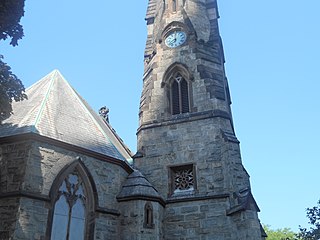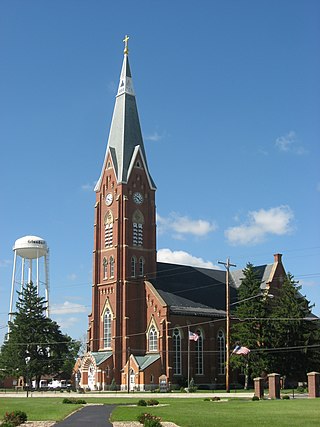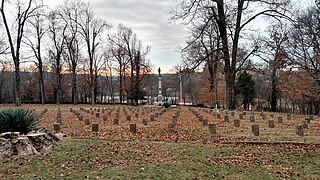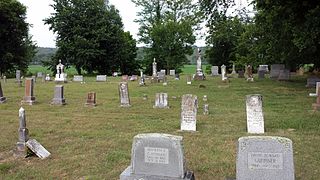
Green-Wood Cemetery is a 478-acre (193 ha) cemetery in the western portion of Brooklyn, New York City. The cemetery is located between South Slope/Greenwood Heights, Park Slope, Windsor Terrace, Borough Park, Kensington, and Sunset Park, and lies several blocks southwest of Prospect Park. Its boundaries include, among other streets, 20th Street to the northeast, Fifth Avenue to the northwest, 36th and 37th Streets to the southwest, Fort Hamilton Parkway to the south, and McDonald Avenue to the east.

Mount Auburn Cemetery, located in Cambridge and Watertown, Massachusetts, is the first rural or garden cemetery in the United States. It is the burial site of many prominent Boston Brahmins, and is a National Historic Landmark.

Lincoln Boyhood National Memorial is a United States presidential memorial and a National Historic Landmark District in Lincoln City, Indiana. It preserves the farm site where Abraham Lincoln lived with his family from 1816 to 1830. During that time, he grew from a 7-year-old boy to a 21-year-old man. His mother, Nancy Hanks Lincoln, and at least 27 other settlers were buried here in the Pioneer Cemetery. His sister Sarah Lincoln Grigsby was buried in the nearby Little Pigeon Baptist Church cemetery, across the street at Lincoln State Park.

Fayetteville National Cemetery is a United States National Cemetery located on the southern side of the city of Fayetteville in Washington County, Arkansas. It encompasses nearly 15 acres (6.1 ha). As of 2020, over 11,000 veterans and family members were interred in this location, with approximately 200 new burials per year.

St. Michael's Church is a historic Episcopal church at 225 West 99th Street and Amsterdam Avenue on Manhattan's Upper West Side in New York City. The parish was founded on the present site in January 1807, at that time in the rural Bloomingdale District. The present limestone Romanesque building, the third on the site, was built in 1890–91 to designs by Robert W. Gibson and added to the National Register of Historic Places in 1996.

Trinity-St. Paul's Episcopal Church in New Rochelle in Westchester County, New York was added to the National Register of Historic Places in 2006. It is located at the northwest corner of Huguenot Street and Division Street. This church represents the body of the majority group of New Rochelle's founding Huguenot French Calvinistic congregation that conformed to the liturgy of the established Church of England in June 1709. King George III gave Trinity its first charter in 1762. After the American Revolutionary War, Trinity became a parish of the Protestant Episcopal Church of America.

Oakwood Cemetery is a nonsectarian rural cemetery in northeastern Troy, New York, United States. It operates under the direction of the Troy Cemetery Association, a non-profit board of directors that deals strictly with the operation of the cemetery. It was established in 1848 in response to the growing rural cemetery movement in New England and went into service in 1850. The cemetery was designed by architect John C. Sidney and underwent its greatest development in the late 19th century under superintendent John Boetcher, who incorporated rare foliage and a clear landscape design strategy. Oakwood was the fourth rural cemetery opened in New York and its governing body was the first rural cemetery association created in the state.

Mount Gilboa Chapel is a historic African Methodist Episcopal Church located in Oella, Maryland, United States. It is a small stone church measuring 28 feet by 42 feet, built about 1859 by free African Americans. The front façade is ashlar masonry, but the sides and rear are of rubble.

Providence Quaker Cemetery and Chapel, also known as Providence Meeting House, is a historic chapel and cemetery located on Quaker Church Road about 2 miles southwest of Perryopolis, Fayette County, Pennsylvania. The cemetery was used by Quakers, but the chapel is not a Quaker structure. Quakers generally refer to a structure built for worship as a meeting house, rather than as a chapel or church.

Hackney Chapel AME Zion Church, also known as Unitia AME Zion Church, is a historic African-American church in rural Loudon County, Tennessee. The adjacent cemetery has about 100 marked graves and up to 200 unmarked graves. The church and cemetery were added to the National Register of Historic Places in 2000.

Prospect Cemetery is a historic cemetery located in the Jamaica section of the New York City borough of Queens. It was established in 1668 and known as the "burring plas." The cemetery's original main gate was on Beaver Road which led from Sutphin Boulevard to Jamaica Avenue. The cemetery was generally known as the Presbyterian burial ground and is one of the few remaining Colonial cemeteries in Queens.

The English coastal city of Brighton and Hove, made up of the formerly separate Boroughs of Brighton and Hove in East Sussex, has a wide range of cemeteries throughout its urban area. Many were established in the mid-19th century, a time in which the Victorian "cult of death" encouraged extravagant, expensive memorials set in carefully cultivated landscapes which were even recommended as tourist attractions. Some of the largest, such as the Extra Mural Cemetery and the Brighton and Preston Cemetery, were set in particularly impressive natural landscapes. Brighton and Hove City Council, the local authority responsible for public services in the city, manages seven cemeteries, one of which also has the city's main crematorium. An eighth cemetery and a second crematorium are owned by a private company. Many cemeteries are full and no longer accept new burials. The council maintains administrative offices and a mortuary at the Woodvale Cemetery, and employs a coroner and support staff.

St. John The Baptist Roman Catholic Church is a historic church at Ohio 694 and Main Street in Glandorf, Ohio. It was built in 1875 and added to the National Register in 1977.

Fayetteville Confederate Cemetery is a cemetery for soldiers of the Confederate States located on the eastern side of Fayetteville in Washington County, Arkansas. Added to the National Register of Historic Places (NRHP) in 1993, the cemetery encompasses 3.5 acres (1.4 ha).

Stokenbury Cemetery is a historic cemetery on Arkansas Highway 16 in Elkins, Arkansas. Established c.1846, it is the best-preserved property representing the early settlement of Elkins. The cemetery is 1.2 acres (0.49 ha) in size, and contains 153 marked and identified graves, 49 graves denoted by unmarked stones, and at least 16 unmarked or illegible burials. It contains several examples of high-style Victorian funerary art.
Marlboro Township, New Jersey has a number of historic sites. The Monmouth County Historic Site Inventory (HSI) was started in 1980 by the directors of both the Monmouth County Historical Association and the Monmouth County Park System. This inventory project provided an inventory number to all historic properties in Monmouth County, New Jersey. In addition to property details, this listing provides reference numbers for easy identification. In addition to the park system inventory, the Marlboro Township Historic Commission provides a listing of Historic Commission Landmarks (HCL). These are physical signs placed in historically significant locations. There was also a list presented by the NJ Department of Environmental Protection - Historic Preservation Office (HPO).

The Mount Olive-Bedford Chapel Cemetery is a historic cemetery in rural White County, Arkansas, northeast of Mount Vernon on Manning Road. It was founded in the 1880s, and is the only surviving remnant of an African-American community called "The Colony". It occupies 1.9 acres (0.77 ha) of basically level ground, and has 86 known burials. Of those, 58 are marked in some way, by some combination of head and foot stones. There are likely more burials on the property. The property includes the Mount Olive Baptist Church, a small clapboarded wood-frame building which has elements dating to the community's founding. The cemetery was listed on the National Register of Historic Places in 2019.


















